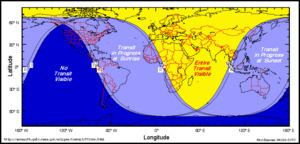 | ||
Date June 7, 2004, 10:13 PM PDT | ||
The second most recent transit of Venus observed from Earth took place on June 8, 2004. The event received significant attention, since it was the first Venus transit after the invention of broadcast media. No human alive at the time had witnessed a previous Venus transit since that transit occurred on December 6, 1882.
Contents
European Southern Observatory (ESO) and the European Association for Astronomy Education (EAAE) launched the VT-2004 project, together with the Institut de Mécanique Céleste et de Calcul des Éphémérides (IMCCE) and the Observatoire de Paris in France, as well as the Astronomical Institute of the Academy of Sciences of the Czech Republic. This project had 2,763 participants all over the world, including nearly 1,000 school classes. The participants made a measurement of the astronomical unit (AU) of 149 608 708 km ± 11 835 km which had only a 0.007% difference to the accepted value.
Visibility
The entire transit was visible from Europe, most of Asia, and almost all of Africa. The beginning was visible before sunset from easternmost Asia and Australia. The end was visible after sunrise from the westernmost fringe of Africa, eastern North America, and much of South America. The transit was not visible at all from western North America, southern South America, Hawaii, or New Zealand. The regions from which the transit were visible are shown on the map to the right.
Timing
The following table and image give times for various events (respectively, first contact, second contact, the midpoint, third contact and fourth contact) during the transit on June 8, 2004 for a hypothetical observer at the center of the Earth. Due to parallax, times observed at different points on Earth may differ from the following by as much as ±7 minutes.
